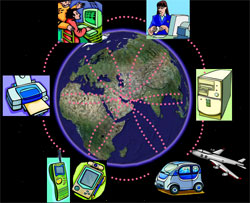'Baggage' is needed to receive the new generation of web
This generation is marked by open, dynamic and highly interactive applications, not only different from traditional webs but also beyond desktop applications. In other words, the web will act as an operating system.
When the web was born in the early 1990s, it immediately changed the way people communicate and receive knowledge. Initially, the web was just a static quantity with basic HTML pages. Then, XML, SOAP (Simple Object Access Protocol) and other technologies have opened the world of SOA (service-oriented architecture) and made complete transformation. All the applications, systems and businesses connect with each other. Following is the Web 2.0 phenomenon with blogs, wikis and social networks.
But as soon as businesses feel they have been able to adapt to the 2.0 trend, the web continues to shift. To "take the lead" in the new web generation, companies will need to prepare:
Building RIA application (Rich Internet Application)
An app called "rich" when it is highly interactive and has rich features and functions with a horizontal user interface, even better than a desktop application. On the web, these features can be the ability to drag - drop data, the mouse menu must change according to the situation and the information is displayed in real time .
One of the technologies that supports RIA is AJAX (asynchronous JavaScript and XML). Interestingly, the majority of AJAX components are "old faces", such as JavaScript. But this also helps users not need to learn new things but can use familiar tools like Microsoft Visual Studio or Adobe Dreamweaver to build applications.
Some other RIA development platforms include Adobe Flex, Microsoft Windows Presentation Foundation, Silverlight .
Open thinking
One of the most remarkable technological revolutions of the past 10 years is web services and SOA. It helps complex applications and databases in the enterprise can be easily merged together.
This is done by "open". As soon as it appeared, SOA implicitly declared if businesses and developers wanted to join the game, they had to accept open standards. Firms that insist on a monopoly understand that being unable to be compatible with standards will cause them to be excluded from development trajectories.
 Maintain dynamic data
Maintain dynamic data
The new application allows people to interact with online data in real time, instead of making them wait for the website to download both new and old information after each change on the page.
In addition, businesses need to pay attention to the Semantic Web theory and related technologies. In the future of Semantic Web, applications not only query and interact with data on the site, but also all other applications on the web.
The ability to work offline
Currently, the tool to support offline (offline) access to the web application is still incomplete and has not yet appeared many activities related to standardizing this accessibility. However, businesses should consider the issue now. When building a new application, don't forget customers will ask: " Is there a way to use the program when my computer is not connected to the Internet? ".
Besides, users expect them to be able to transform applications in their own way to suit their specific needs (this capability is called mash-ups). Previous software firms strictly control how applications are used, upgraded and integrated. However, in the new trend, the fact that a program is not easily customized or mixed with other programs will be considered a discarded application.
You should read it
- How to fix the error cannot delete the application on Mac OS
- 5 ways to open applications in Windows 10
- Warning: Cyber attacks targeting web applications increase rapidly in 2019
- Add, remove startup applications with Windows 8
- How to list all applications on Mac
- How to lock applications that require extreme security on Android
 Browse photos quickly in ACDSee
Browse photos quickly in ACDSee 5 tips for blogging
5 tips for blogging Discover Yahoo! Mash
Discover Yahoo! Mash Magical moments of the web (Part 1)
Magical moments of the web (Part 1) The magical moments of the web (part 2)
The magical moments of the web (part 2) Cool the computer in the summer
Cool the computer in the summer